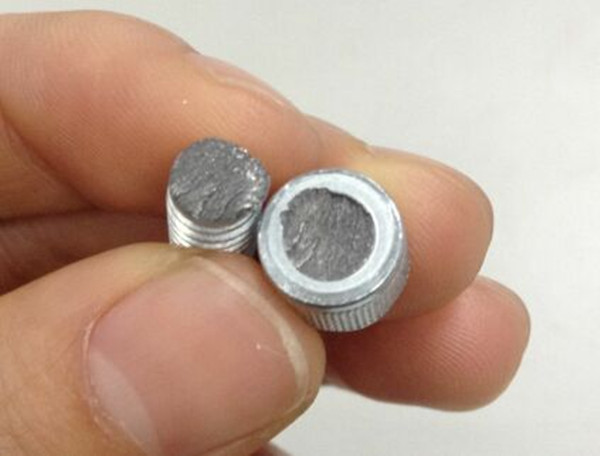Example: The US-standard hexagonal head screw of class 12.9 has a fracture during assembly.
During the assembly of the 12.9-level hexagon socket screws, the customer found that the screws broke from the neck.

In the process of assembling the 12.9-class American hexagon socket head cap screws, the customer broke the neck and analyzed the cause of the fracture of this high-strength screw. The following possibilities are possible:
1. Equipment problem, this screw is made by single-mode machine instead of multi-station, and the single-mode equipment may be too concentrated when punching;
2, the inner hexagon groove is deep, the bottom is thin, and it is easy to break;
3. Hydrogen embrittlement problem.
To this end, engineers used the inventory parts to do two damage torsion tests in accordance with the standard, one is the torque under normal use conditions, and the other is to simulate the customer's root fracture surface. The engineers found that the two screws in the experiment were in compliance with the standard and there was no fracture from the neck. The cause of the fracture was unknown. For this business, the customer and the technical inspection department engineers are required to conduct on-site use verification. At the same time, the Purchasing Department actively supported the initiation of supplier management proposed by the Technical Inspection Department. In the spot check on the electroplater, the electroplater lacked basic knowledge of dehydrogenation. Regardless of the material, plating requirements, hardness of the plated parts, and grade of the plated parts, all of them were temperature and time grades. Hydrogen, and the placement of the plated parts into the dehydrogenation furnace is extremely irregular. Basically, the plated parts are poured onto the tray. These dehydrogenated parts are processed in a stacked state, and the result must be incomplete. On the spot, the technician of the technical inspection department proposed to carry out a reasonable dehydrogenation process according to the specifications. At this time, the technical person in charge of the electroplater recognized the seriousness of the hydrogen embrittlement consequences, and clearly stated that it must be carried out in accordance with the customer's regulations and the correct dehydrogenation process in the future. operation.

By doing two damage torsion experiments, the screws did not break from the neck.
The cargo ship period for the customer's assembly product has been confirmed, and the supplier is urgently required to replenish the goods. The supplier business department is careful to deliver the goods, and the technical inspection department engineer also visits the customer's technical and quality person in charge. Also at the production site to understand the cause of the screw break, and to view the customer's production SOP. The customer actively cooperated with the analysis of the broken screws. The engineers found that the location of the fracture was at the root and was the typical hydrogen embrittlement position indicated in the textbook. This proves that the cause of the problem is that the electroplater is not completely dehydrogenated. The customer asked if the bolt has been supplied for several years without breaking. How did the break occur this time? Since we have made detailed preparations and saw the assembly situation on site, the main reason for our clear answer is hydrogen embrittlement. The secondary reason is that the customer does not have a reasonable leveling assembly process. In view of the hardness of the electroplated fasteners exceeding HRC39, regardless of whether the hydrogen flooding treatment is thorough, there is a risk of hydrogen embrittlement. The supplier engineers stand on the customer's stand to improve the replacement of the electroplated parts. Since the customer is very urgent, thank you first. The new recommendations of the supplier engineers will be discussed later, and we will actively cooperate with us to carry out the correct lock bolt process control at the production site.
In order to ensure the safety of customers' products, the supplier began to prepare for the dehydrogenation process. In the future, as a mandatory document, it will be distributed to the electroplating company along with the purchase order, and the customer safety will be ensured in the system management.
The following is a little knowledge about the risk of hydrogen embrittlement:
1. Under normal circumstances, products with hardness greater than 32HRC have the risk of hydrogen embrittlement. Therefore, all products of grade 10.9 or higher (including grade 10.9) and products subjected to carburization heat treatment (self-tapping screws) will be exposed to hydrogen embrittlement.
2. Hydrogen embrittlement means that when the product is electroplated, H+ enters the inside of the metal to form bubbles, which causes the lattice to be distorted. Then, under the action of external force, the internal stress of the hydrogen atom after the creeping position of the crystal lattice is released. In terms of fasteners, since the torque after locking the screw is fixed, it continues to stretch, causing the screw to be on the spot during use, and delayed fracture occurs for a considerable period of time.
3. In the fastener industry, products with hydrogen embrittlement risk are generally within 1 hour after electroplating, and need to be sent to a hydrogen furnace for hydrogen driving at a specified time and at a specified temperature. This is called dehydrogenation. .
4, hydrogen embrittlement treatment can greatly reduce the risk of hydrogen embrittlement, but can not be completely avoided, so in the case of the need to ensure 100% no risk of hydrogen embrittlement, the use of electroplating products is strictly prohibited; and the use of Dacromet, Kumite, sandblasting, etc. Surface treatment process. (Article source: Suzhou Hongyi screw, especially thanks to Hongyi screw real case sharing)
Light Powder-actuated Fastening Tool is low velocity powder actuated, single shot, .22 caliber tool which is designed for light base and concrete not harder than C40.
Light Powder-Actuated Fastening Tool
Light Powder-Actuated Fastening Tool ,Direct Fastening,Powder Tool,Powder Actuated Tools
Yibin Heheng Technology Co.,Ltd , https://www.actuated.nl